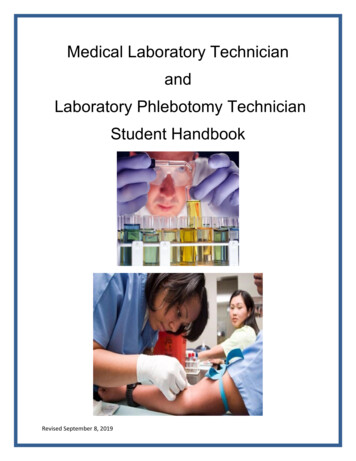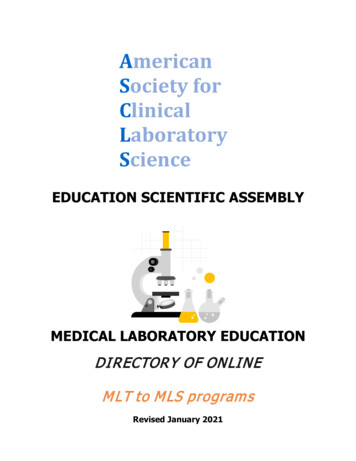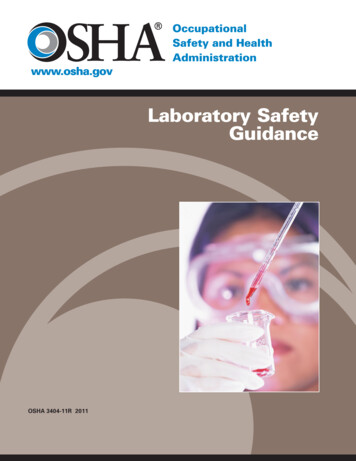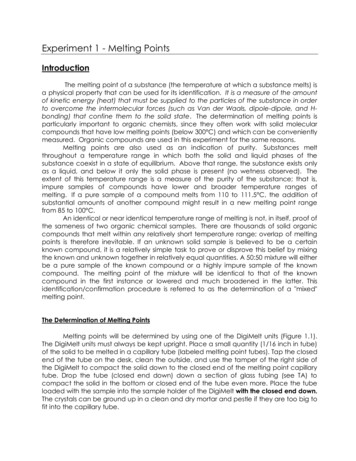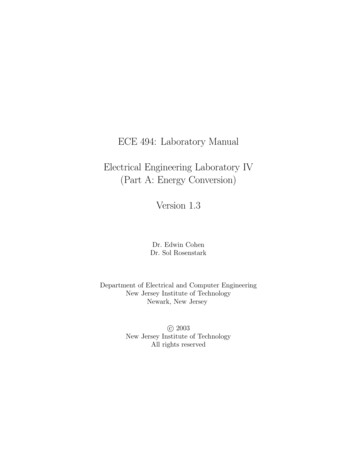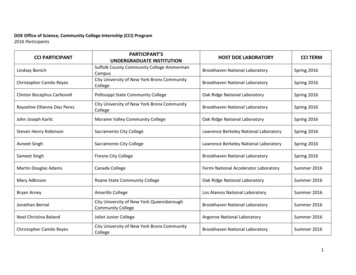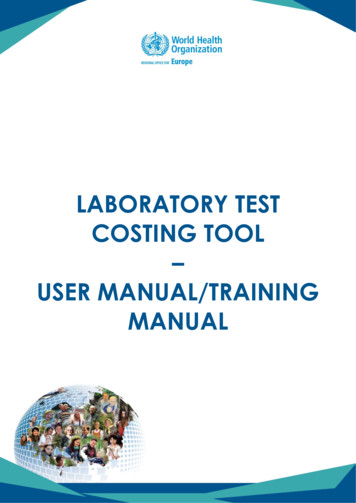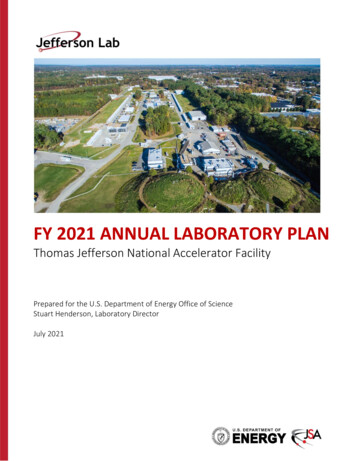
Transcription
FY 2021 ANNUAL LABORATORY PLANThomas Jefferson National Accelerator FacilityPrepared for the U.S. Department of Energy Office of ScienceStuart Henderson, Laboratory DirectorJuly 2021
Table of ContentsI. Mission/Overview. 1II. Lab-at-a-Glance . 1III. Core Capabilities . 2Nuclear Physics. 2Accelerator Science and Technology . 3Large Scale User Facilities/Advanced Instrumentation . 5IV. Science and Technology Strategy for the Future/Major Initiatives . 7V. Infrastructure . 8Overview of Site Facilities and Infrastructure . 8Campus Strategy. 9Site Sustainability Plan Summary . 16Enclosure 1 – Land Use Plan . 18Enclosure 2 – Infrastructure Investment Table . 19Enclosure 2 (cont’d) – SC Integrated Facilities and Infrastructure (IFI) Crosscut Data Table . 20
I. Mission/OverviewThomas Jefferson National Accelerator Facility (TJNAF) isa world-leading research institution for exploring thenature of matter in depth, providing unprecedentedinsight into the details of the particles and forces thatbuild our visible universe inside the nucleus of the atom.TJNAF was established in 1984 in Newport News,Virginia, and is operated by Jefferson Science Associates,LLC, for the Department of Energy’s Office of Science.II. Lab-at-a-GlanceLocation: Newport News, VirginiaType: Program-dedicated, single-purpose labContract Operator: Jefferson Science Associates,LLC (JSA)Responsible Site Office: Thomas Jefferson SiteOfficeWebsite: http://www.jlab.orgResearch at TJNAF reveals the fine details of theconstituents of matter, from the familiar protons,neutrons, and electrons in the atom, to the lesserknown quarks and gluons inside the atom’s nucleus.These studies are revealing how fundamental universalforces build and shape matter and are opening awindow into matter’s inner universe.Enabling these studies is TJNAF’s world leadership in thedevelopment and deployment of large-scalesuperconducting radiofrequency (SRF) technology. SRFtechnology powers TJNAF’s flagship machine, theContinuous Electron Beam Accelerator Facility (CEBAF).The technological and research successes accomplishedwith CEBAF as a unique SRF particle accelerator havemade possible a wide array of applications, from evermore powerful free-electron lasers for research to lifesaving advances in nuclear medicine, and from impactfulapplications in industry to real-world solutions forprotecting our nation’s borders.In support of its scientific mission, TJNAF maintains corecapabilities and expertise in Nuclear Physics; AcceleratorScience and Technology; and Large Scale UserFacilities/Advanced Instrumentation. TJNAF is alsoexploring ways to capitalize on its expertise in thecomputational sciences to provide large-scale highperformance computing services to an array of researchfields for accelerating and maximizing scientific insightin the future.TJNAF actively partners with industry to advance criticaltechnologies to benefit the nation. The lab is alsoinvesting in the next-generation STEM workforce. Itsdedicated research facilities enable one-third of U.S.Ph.D.s in nuclear physics annually, and its outreachprograms positively impact thousands of students andteachers while helping them build critical knowledgeand skills for a brighter future.Physical Assets: 169 acres and 69 buildings 882,900 gross square feet (GSF) in buildings Replacement Plant Value (RPV): 509M 0 GSF in excess facilities 66,289 GSF in leased facilitiesHuman Capital (period ending 9/30/2020): 744 FTEs 24 joint faculty 36 postdoctoral researchers 21 undergraduate and 44 graduate students 1,623 facility users 1,488 visiting scientistsFY 2020 Costs by Funding Source:(Cost Data in M)Other SC,4.4Other DOE,9.5SPP,1.5ASCR,0.2HEP,0.6BES,9.2NP,136.2BES costs ( 9.2M) reflect LCLS-II & LCLS-II HE work for SLACLab Operating Costs: 161.7DOE Costs: 160.2SPP (Non-DOE/Non-DHS) Costs: 1.5DHS Costs: 0.0SPP as % Total Lab Operating Costs: 0.9%Thomas Jefferson National Accelerator Facility FY21 Annual Laboratory Plan, April 2021Lab Operating Costs: 162.1
III. Core CapabilitiesNuclear PhysicsTJNAF is a unique world-leading user facility for discovery studies of the structure of nuclear andhadronic matter using continuous beams of high-energy, polarized electrons. The 2015 NSAC(Nuclear Science Advisory Committee) Long Range Plan clearly stated that its highest priority wasto capitalize on this investment: “With the imminent completion of the CEBAF 12 GeV upgrade, itsforefront program of using electrons to unfold the quark and gluon structure of hadrons andnuclei and to probe the Standard Model must be realized.”The CEBAF electron beam can be simultaneously delivered to the experimental halls at differentenergies. With the completion of the 12 GeV Upgrade the beam energy can be up to 12 GeV,converted to 9 GeV photons for experimental Hall D, and up to 11 GeV to Halls A, B, and C. Eachexperimental hall is instrumented with specialized experimental equipment designed to exploitthe CEBAF beam. The detector and data acquisition capabilities at TJNAF, when coupled with thehigh-energy electron beams, provide the highest luminosity (1039/eN/cm2/s) capability in theworld. The TJNAF staff designs, constructs, and operates the complete set of equipment to enablethis world-class experimental nuclear physics program, in close collaboration with a large domesticand international user community of well over 1,600 users annually.The CEBAF science program spans a broad range of topics in modern nuclear physics. LatticeQuantum Chromodynamics (LQCD) calculations predict the existence of new exotic hybrid mesonsthat can be discovered with the new 12 GeV experiments, and elucidate the nature ofconfinement. New phenomenological tools have been developed that produce multidimensionalimages of hadrons with great promise to reveal the dynamics of the key underlying degrees offreedom – a new science program termed Nuclear Femtography. A surprising connection betweenthe role of nucleon-nucleon interactions and the quark structure of many nucleon systemsdiscovered at TJNAF earlier, needs to be understood. Development of measurements ofexceptionally small parity-violating asymmetries with high precision has enabled major advancesin hadronic structure, the structure of heavy nuclei (through measurement of the neutrondistribution radius), and precision tests of the Standard Model of particle physics, including ameasurement of the electron’s weak charge.A comprehensive theoretical effort provides leadership across nuclear physics by pulling togetherstate-of-the art theoretical, phenomenological, and computational approaches, including effectivefield theory techniques, QCD global analyses, and non-perturbative LQCD calculations. TJNAFdeploys cost-optimized High Performance Computing for LQCD calculations as a national facilityfor the USQCD (a U.S. lattice gauge theory community) that complements DOE’s investment inleadership-class computing. Computational techniques in LQCD now promise to provide insightfuland quantitative predictions that can be meaningfully confronted with and elucidated byforthcoming experimental data. Those techniques also promise to calculate the structure ofhadrons that are hard, if not impossible, to do scattering experiments with.Thomas Jefferson National Accelerator Facility FY21 Annual Laboratory Plan, July 20212
Excellent synergy exists between the TJNAF experimental, theoretical, and computing programs.The Joint Physics Analysis Center (JPAC) develops theoretical and phenomenologicalunderstanding of production and decays of hadron resonances, which helps bridge the analysesand interpretation of experimental data from TJNAF with the results of LQCD calculations. TheJefferson Lab Angular Momentum (JAM) collaboration pulls expertise in QCD theory,phenomenology, and high performance computing to develop new and better tools to helpextract the 3D tomography of hadrons from TJNAF data. TJNAF was the first to make use ofGraphics Processing Units for high performance computing based on heterogeneous architectures(for LQCD calculations) and continues this innovative approach to present needs, including wideembracement of Machine Learning and Artificial Intelligence in Nuclear Physics techniques.The 2015 NSAC LRP recommends a “high-energy high-luminosity polarized EIC as the highestpriority for new facility construction following the completion of FRIB.” An independentassessment of the science case for EIC was undertaken by a committee of the National Academiesof Science in 2016-18. The committee made their findings public in July 2018, strongly supportingthe case for a U.S.-based EIC. Following the decision to select BNL as the site of the EIC, TJNAFactively worked with BNL to provide important expertise and capability to ensure successfulimplementation of the EIC, including taking responsibility of scope that benefits from TJNAF’slong-time intellectual investment in the EIC, TJNAF’s core expertise, and its wide international usercommunity. TJNAF played a fundamental role initiating and expanding the international EIC UserGroup that has now grown to 1,266 individual members from 253 institutions in 34 countries, witha large contribution of TJNAF users.TJNAF scientists are heavily engaged in the community effort and its phenomenological studies torefine the strong science case and help develop unique detection capabilities for the future EIC,including the year-long and user-driven Yellow Report Initiative. The purpose of this Yellow ReportInitiative, initiated by TJNAF scientists, was to advance the state and detail of the documentedphysics studies in preparation for the realization of the EIC. The effort aims to provide the basis forfurther development of concepts for experimental equipment best suited for science needs,including complementarity of two detectors towards future Technical Design Reports (TDRs).TJNAF has consolidated its efforts in the development of the science program by forming anElectron-Ion Collider Center (EIC2). Seminars, visiting fellows, and workshops will be among thecomponents of this new center.Accelerator Science and TechnologyTJNAF has world-leading capabilities in technologies required for superconducting linacs: Complete concept-to-delivery of superconducting linear accelerators State-of-the-art SRF fabrication and assembly capabilities Unrivaled design, commissioning, and operations experience in large cryogenic plants World-leading polarized electron injector capabilities Low-level RF and controls Accelerator and large-scale control systems Accelerator operation and designThomas Jefferson National Accelerator Facility FY21 Annual Laboratory Plan, July 20213
One of the key core capabilities of TJNAF is its capability in SRF system design and production. TheSRF accelerator system consists of multiple integrated technologies with expertise spreadthroughout multiple disciplines and departments. TJNAF maintains collaboration andcommunication among all associated sub-systems essential to maintaining and enhancing SRFcapabilities. System integration essential to an effective SRF system includes cavity fabrication andprocessing, cryomodules, low-level RF controls, high-power RF, cryogenics, software and hardwarecontrols, and monitoring systems. Ensuring that each of these sub-systems maintains state-of-theart capabilities is critical to maintaining a world-leading program in SRF accelerator systemcapabilities. To accomplish the mission, the SRF Institute must maintain a comprehensive set ofexpertise and facilities to support SRF technologies at TJNAF and be ready to respond to currentand future needs of the lab, the DOE complex, and other partners. TJNAF’s SRF Facilities occupyabout 60,000 SF of contiguous space all under one roof, which includes over 30,000 SF of newwork centers, 25,000 SF of renovated high bay assembly and test work centers, and about 5,000SF for parts inventory and storage. A unique feature of the SRF facility is the 800 m2chemroom/cleanroom suite. This state-of-the-art facility is fully engaged to support LCLS-II HE,SNS PPU, critical fundamental SRF R&D, and future projects such as EIC, PERLE, and the ILC.The Upgraded Injector Test Facility (UITF) underwent a series of Accelerator Readiness reviewsand was fully commissioned in the fall of 2020. The UITF is now certified as an accelerator facilityand is operational. During the initial phase of operations, TJNAF has completed a series ofexperiments to characterize the HDice polarized target, conducted commissioning studies for thenew SRF “booster” cryomodule, to be installed in CEBAF during the 2022 shutdown, demonstratednext-generation LLRF controls performance in support of an AIP-funded project, and supportedSBIR grants to study advanced polarimetry diagnostics. A new beamline for environmentalapplications, supported by LDRD funds, will be installed in the spring of 2021. The first experimentwill be in collaboration with the Hampton Roads Sanitation District to study the effectiveness of ebeam irradiation to break down a ubiquitous solvent 1,4-Dioxane in wastewater. The facility willthen be used to conduct the first ever testing with beam of Nb3Sn coated cavities operating at 4K.This work is supported by an Early Career Award.Electron-Ion Collider (EIC) DesignThe Accelerator Division, in partnership with the Physics Division and collaborators at othernational laboratories, developed a design concept for a Jefferson Lab Electron Ion Collider (JLEIC).A design report for JLEIC was published in 2012, to respond to the energy and luminosityrequirements of the EIC physics white paper. The JLEIC design team, composed of TJNAFpersonnel and strategic national and international collaborators, developed a pre-ConceptualDesign Report (pre-CDR) in FY 2018 and FY 2019. These design efforts influenced and continue toinfluence the EIC project that started in FY20, with TJNAF as a major partner in the overall facilitydesign and performance objectives. In particular, the portability of some key strengths of the JLEICdesign were investigated and led to a possible increase of the luminosity of the BNL-basedElectron-Ion Collider by nearly a factor of two at lower Center-of-Mass Energies. The design effortswere also instrumental to study the feasibility of a possible second Interaction Region design withsomewhat increased crossing angle but a stronger emphasis of forward detection, to enhancescience complementarity. These design optimizations are under further study now.Thomas Jefferson National Accelerator Facility FY21 Annual Laboratory Plan, July 20214
Large Scale User Facilities/Advanced InstrumentationExperimental Nuclear Physics (funded by DOE SC – Nuclear Physics)TJNAF is the world’s leading user facility for studies of the quark structure of matter usingcontinuous beams of high-energy, polarized electrons. With well over 1,600 users annually, ofwhich roughly two-thirds are domestic, TJNAF supports what is generally considered the largestnuclear physics user community in the world. CEBAF is housed in a seven-eighths mile racetrackand was built to deliver precise electron beams to three experimental end stations or halls. Theelectron beam can be converted into a precise photon beam for delivery to a fourth experimentalHall D. Accelerator instrumentation is installed to deliver beams to all four halls simultaneously.CEBAF provides a set of unique experimental capabilities unmatched in the world, as follows: Highest energy electron probes of nuclear matter Highest average current Highest polarization Ability to deliver a range of beam energies and currents to multiple experimental hallssimultaneously Highest-intensity tagged photon beam at 9 GeV for exotic meson searches Unprecedented stability and control of beam properties under helicity reversal for highprecision parity violation studiesHall D is dedicated to the operation of a hermetic large-acceptance detector for photon-beamexperiments, known as GlueX. Hall A houses two high-resolution magnetic spectrometers of some100 feet in length and a plethora of auxiliary detector systems, including the large-acceptanceSuper BigBite Spectrometer. Hall B is home of the CEBAF large-acceptance spectrometer (CLAS12)with multiple detector systems and some 100,000 readout channels. Hall C boasts two roughly 80foot-long, high-momentum magnetic spectrometers that allow for precision scatteringexperiments, and has housed many unique large-installation experiments. Maintenance,operations, and improvements of the accelerator beam enclosure and beam quality, and thecavernous experimental halls and the multiple devices in them, are conducted by the TJNAF staffto facilitate user experiments. Important capabilities related to the experimental program includestate-of-the-art particle detection systems, high-power cryogenic targets, polarized targets, highspeed readout electronics, and advanced data acquisition technology.CEBAF Operations (funded by DOE SC – Nuclear Physics)CEBAF is in the midst of a long shutdown to install a new 2K cold box, perform maintenance on thein-tunnel cryogenic transfer line system, refurbish warm girder segments between cryomodules tomitigate any potential particulate contamination, complete the first phase of an upgrade to theInjector for the parity program, and conduct extensive planned maintenance on many subsystems.The Energy Reach program will also install two refurbished cryomodules and remove one more toseed the refurbishment program. In late summer TJNAF will resume its primary mission of the 4Hall 12 GeV Physics program. The multi-year CEBAF Performance Plan and Energy Reach programsare well underway and will continue to ensure TJNAF meets reliability goals and provideoperational energy margin for the Physics program. In the following year the lab will complete theThomas Jefferson National Accelerator Facility FY21 Annual Laboratory Plan, July 20215
second phase of the Injector upgrade. As mentioned above, plans are underway to preparetechnical reports that pave the way towards an increase in the CEBAF luminosity by 50% and todouble the energy using FFA technology. With the completion of the 12 GeV Upgrade, firm plansin place for maintenance and energy reach as well as a vision towards the future, TJNAF willcontinue to be the world’s premier experimental QCD facility.Accelerator Technology (funded by DOE SC – Nuclear Physics, Basic Energy Sciences, High EnergyPhysics, DOD ONR, Commonwealth of Virginia, and Industry)The ability to use the TJNAF Low Energy Recirculator Facility (LERF) as an accelerator R&D test bedfor Energy Recovery Linacs and techniques required to establish cooling of proton/ion beams, forexample, provides a mutually beneficial cross-fertilization between the TJNAF LERF and NuclearPhysics. The LERF vault has recently been configured to enable higher throughput of cryomoduletesting for LCLS-II HE. In addition, the LERF is supporting an R&D program to develop anaccelerator-based concept to make Cu-67, a potentially useful radioisotope for medical imagingand radiotherapy.TJNAF is applying its accelerator technology to collaborate with four other national laboratories torealize the Linac Coherent Light Source II, at the Stanford Linear Accelerator Center (LCLS-II atSLAC). TJNAF was responsible for construction of half of the superconducting cryomodules as wellas the two cryogenic refrigeration plants. The lab expects to contribute to the commissioningeffort for the accelerator as well as the cryogenics plants in the next year. An LCLS-II upgrade,LCLS-II-HE, is also underway to double the energy of LCLS-II from 4 to 8 GeV and extend the X-rayenergy limit from 5 keV to 12.8 keV. TJNAF will build 10 cryomodules for the LCLS-II-HE project.TJNAF has been selected to produce cryomodules for the Spallation Neutron Source Proton PowerUpgrade (SNS PPU). The scope of the project is to build 7 new high beta cryomodules with 28 newSRF cavities to increase the SNS linac beam energy to 1.3 GeV. Vendor-provided cavities havestarted to arrive and are being qualified in our Vertical Test Area.Cryogenics (funded by DOE SC – Nuclear Physics)Over the last 25 years, TJNAF has developed a unique capability in large-scale cryogenic systemdesign and operation that is a critical resource for the U.S. national laboratory complex. The TJNAFcryogenics group has been instrumental in the design of many construction projects requiringlarge-scale cryogenics: SLAC (LCLS-II), Michigan State University (FRIB), Oak Ridge National Lab(SNS), TJNAF (12 GeV Upgrade), and NASA (James Webb Space Telescope), as well as improvingthe cryogenic efficiency of existing systems (Brookhaven National Laboratory). In the process,many inventions have been patented, and one has been licensed by Linde (one of two companiesthat build cryogenic systems) for worldwide applications on new and existing cryogenic plants.This work has also resulted in many master’s and Ph.D. theses, to ensure the continuity of thisexpertise in the coming decades.The group has completed the design, specification, and procurement—and started thecommissioning—of the helium refrigerators for LCLS-II. This work is based on the successful CHL2design for the 12 GeV Upgrade and designs developed for FRIB. Significant CEBAF upgrades inprogress include the installation of a replacement 2K cold box for CEBAF operations which wasfabricated at TJNAF using the latest cold compressor technology. Installation and commissioning ofThomas Jefferson National Accelerator Facility FY21 Annual Laboratory Plan, July 20216
this cold box is to be completed by July 2021. Work continues on the modification and installation of asurplus SSC refrigerator, ESR-2, to support future CEBAF end-station operations. Additionally, projectwork including procurement of equipment is underway to utilize funding received to upgrade the 2Kcapacity of the Cryogenic Test Facility that supports superconducting cavity and magnet testing at theTest Lab. The combination of ongoing operations of five refrigerators supporting the TJNAFexperimental program, the upgrading of those refrigerators, and the work outside the lab has enabledthe training of the next generation of cryogenic engineers in the newest technology as well as thedetails of plant operations supporting a dynamic experimental program.IV. Science and Technology Strategy for the Future/Major InitiativesThe TJNAF science strategy for the future involves pursuit of four major initiatives that advance keyobjectives in the field of Nuclear Physics and also position the lab to more broadly contribute to theprograms in the Office of Science. These initiatives position TJNAF to diversify its scientific mission bybuilding upon our foundation in nuclear physics research to pursue new research directions andfacility capabilities, particularly in advanced computing.The first major initiative is Nuclear Physics at CEBAF. The currently planned program of experimentswill require the better part of the next decade to execute. However, CEBAF will continue to provideunique capabilities to advance our understanding of hadronic matter at high luminosity far beyondwhat will be available at the future EIC. Advances in nuclear theory, particularly first principlescalculations in Lattice Quantum Chromodynamics, provide essential support for future developmentsat CEBAF and EIC. TJNAF envisions a series of modest upgrades to increase luminosity, enable positronbeams, and double the energy of CEBAF.The CEBAF facility also offers unique opportunities for testing the Standard Model and searching fornew physics beyond the Standard Model. An excellent example is the Heavy Photon Searchexperiment that was constructed in collaboration with SLAC (with DOE-HEP funding). TJNAF also hasan approved program, “Electrons for Neutrinos,” that will provide important data relevant toanalyzing the flagship experiment DUNE at Fermilab and the Sanford Underground Research Facility. Anew proposal to search for dark matter particles emitted by the CEBAF beam dump, parasitically withthe NP program, has been recommended for approval by our Program Advisory Committee. TJNAFwould welcome an opportunity to discuss with DOE-HEP how to realize these important objectivesand maximize the scientific impact of the CEBAF facility.TJNAF has established itself as a major partner in the development, construction, and scientificutilization of the new Electron-Ion Collider Project, the second major initiative. This effort is bothsynergistic and complementary to the Nuclear Physics program at CEBAF, and exploits TJNAF’s worldleading expertise in utilizing electron scattering in experimental nuclear physics as well as acceleratorscience and technology.The third major initiative is Accelerator Science and Technology. TJNAF will continue to be a worldleading center for SRF technology research and production, both for fundamental scientific researchand for applications to industry, medicine, and national security. Machine learning for acceleratoroperations and advanced photocathode development are additional elements of this initiative.TJNAF will continue to advance the role of computation in Nuclear Physics while expanding ourhorizon beyond Nuclear Physics to other disciplines and research areas. TJNAF has developed a visionThomas Jefferson National Accelerator Facility FY21 Annual Laboratory Plan, July 20217
for an advanced computational facility to accelerate scientific discovery across DOE Office of Scienceprograms by providing large-scale high-performance computing that brings parity between simulated,experimental, and observational data to accelerate and maximize scientific insight. This facility willprovide services to Office of Science programs that enable interdisciplinary teams of scientists toattack fundamental problems in science and engineering that require nimble shared access to largedata sets, often aggregated from multiple sources.V. InfrastructureTJNAF describes plans to maintain and improve its physical infrastructure and human capitalresources while minimizing overhead cost to maximize return on science and technology investment.These plans are aligned with the FY 2021 Laboratory Agenda and its four strategic objectives. In theprevious sections of this plan, the three strategic objectives that encompass the S&T mission of thelaboratory were addressed. The remainder of this plan reflects the actions required to achieve thefourth and final strategic outcome related to laboratory operations that provide a strong foundationfor sustained research and development excellence at TJNAF: Provide, protect, and improve thehuman, physical, and information resources that enable world-class science.Overview of Site Facilities and InfrastructureTJNAF is located on a 169-acre DOE-owned federal reservation within the City of Newport News insoutheast Virginia. Adjacent to the federal reservation is the Virginia Associated Research Campus(VARC), a 5-acre parcel owned by the Commonwealth of Virginia and leased by SURA which sub-leasesfive acres to DOE for TJNAF use. Also adjacent is an 11-acre parcel owned by Newport News thatcontains the Applied Research Center (ARC) where JSA leases additional office and lab space. SURAowns 37 acres adjacent to TJNAF where it operates a 42-room Residence Facility at no cost to DOE.TJNAF consists of 69 DOE-owned buildings comprising 882,990 square feet (SF) of office, shop,technical, and storage space. JSA leases additional office and lab space in the VARC (37,643 SF) andARC (11,097 SF). JSA also leases two off-site storage warehouses (17,549 SF). Distribution of space bytype is summarized in Table 4. There are currently no excess facilities and none are expected withinthe next 10 years. In addition to real property assets, 42 personal property shipping containersrepresent 12,920 SF of added storage.Table 4: Distribution of Usable Space by TypeType of UseTechnical and LaboratoryHigh BayOfficeStorageCommonTOTALTotal Usable Square Feet,Owned and Leased258,768 (39%)150,198 (23%)101,420 (16%)92,847 (14%)54,579 (8%)657,812 (100%)TJNAF provides office and workspace forapproximately 760 JSA contractor, JSA, andfederal government employees plus 1,600transient users and visiting scientists. Facilityspace is well utilized with a current assetutilization index of 99.6%. The condition ofTJNAF facilities is generally good as
Stuart Henderson, Laboratory Director July 2021 . Table of Contents . state-of-the art theoretical, phenomenological, and computational approaches, including effective . the SRF Institute must maintain a comprehensive set of expertise and facilities to support SRF technologies at TJNAF and be ready to respond to current and future needs of .


